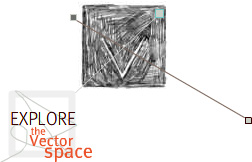Programmed Visions
Design by Raegan Kelly
Designer's Statement
One of the many threads running through Wendy's work entails a critical examination of practices of reduction and simplification at the surface that in the end can become (have become?) a kind of mechanistic truth. Following this, I first envisioned the Programmed Visions interface as an extended and never quite containable complex surface, one that foregrounded its opacity and consciously eschewed some interactive standards and practices that can imply complete (user) control, and access. Access to and through this surface would only be achieved through prolonged physical engagement.
In the end, we honed structurally closer to Foucault's contextual archival volume and added 'depth' (implied by transparency) to the interface. Wendy worked hard to physically locate her materials according to her argument, settling on 37 cartesian fields stacked along a hypothetical z-axis, organized into thematic quadrants and around two possible origins”"the corner (0,0), and, counting row by row and column by column, the center (6,6). The 38th or foremost field contains Wendy's own analytical texts.
Wendy then selected hot snippets from each text segment, which through string matching respond to mouse proximity and link to a varying number of locations elsewhere in the archive. My original navigational algorithm generated a curated path through this material, with each text segment or snippet containing code linking it to one, possibly two, other texts or images in the archive. Each reader's path would have been unique, as there are generally several texts (and many active snippets of each text) present at any one time within the frame, but somewhat rigidly prescribed. Wendy chose to relinquish that control, opting instead to generate a list of keywords as indices to the contents of the database, and associating a number of keywords with any given text/image. The archive overview, a bird's eye view of the structure of the archive that emerges through interaction, provides a historical index back through the piece.



